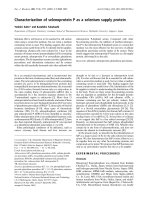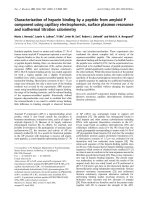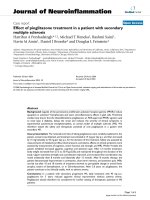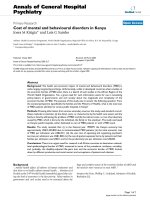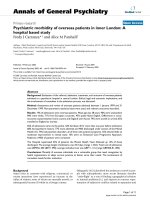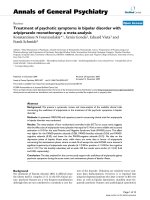Báo cáo y học: "Cost of intensive care in a Norwegian University hospital 1997–1999" doc
Bạn đang xem bản rút gọn của tài liệu. Xem và tải ngay bản đầy đủ của tài liệu tại đây (81.61 KB, 7 trang )
72
Critical Care February 2003 Vol 7 No 1 Flaatten and Kvåle
Research
Cost of intensive care in a Norwegian University hospital
1997–1999
Hans Flaatten
1
and Reidar Kvåle
2
1
Director of Intensive Care Unit, Department of Anaesthesia and Intensive Care, Haukeland University Hospital, Bergen, Norway
2
Consultant, Department of Anaesthesia and Intensive Care, Haukeland University Hospital, Bergen, Norway
Correspondence: Hans Flaatten,
Introduction
The increasing cost of modern medicine is a challenge. Health
authorities and government of care try to reduce costs, or at
least to reduce the increases in costs of health care. The
patients (consumers) demand an increasing amount and range
of treatments, and in between is the health care deliverer
(physician) trying to combine such seemingly opposite inputs.
It is generally claimed that intensive care is very expensive. In
the USA the sum of resources used for intensive care is esti-
mated to be 1% of the Gross National Product [1], while it is
probably considerably less in European countries [2]. On the
other hand, intensive care in underdeveloped countries often
does not exist beyond the recovery room.
ICU = intensive care unit; QALY = quality adjusted life-years; QOL = quality of life.
Abstract
Aim The present study was performed in order to document costs of intensive care in a Norwegian
university hospital and to perform an average cost-effectiveness study using the expected remaining
life-years in survivors after 18 months.
Materials and methods Patients admitted to the general intensive care unit (ICU) at Haukeland
University Hospital from 1997 to 1999 were followed up to 18 months post ICU using data from the
Norwegian Peoples’ registry. Our ICU patients have a further mortality equal to the average population
in Norway from that time. By creating an age-matched and sex-matched sample of the general
Norwegian population equal to survivors 18 months after ICU treatment, we could find the expected
further survival time for each ICU survivor. Direct and indirect ICU expenses in the study period were
retrieved using a ‘top-down’ method. Outcome assessment was performed using the total ICU
expenses in the period divided by the sum of the life expectancy (years) in survivors after 18 months.
Results The total ICU costs (converted to 2001 values) were € 16,697,415, excluding the costs of
radiology and the use of operating theatres, which were both impossible to retrieve. A total of 1051
patients were treated, of whom 60.9% survived up to 18 months. Further total life expectancies were
24,428 years. The average costs of an ICU day and stay per patient were € 2601 and € 14,223,
respectively, and the average cost per year of survival per patient was € 684.
Discussion The absolute costs were found to be higher than recent European ICU studies reporting
on the cost of ICU treatment. However, the price of a further life-year in survivors was lower and was
comparable with other medical treatment.
Keywords intensive care/economics, life expectancy, outcome assessment (health care)
Received: 26 June 2002
Revisions requested: 4 October 2002
Revisions received: 18 November 2002
Accepted: 26 November 2002
Published: 18 December 2002
Critical Care 2003, 7:72-78 (DOI 10.1186/cc1865)
This article is online at />© 2003 Flaatten and Kvåle et al., licensee BioMed Central Ltd
(Print ISSN 1364-8535; Online ISSN 1466-609X). This is an Open
Access article: verbatim copying and redistribution of this article are
permitted in all media for any non-commercial purpose, provided this
notice is preserved along with the article's original URL.
Open Access
73
Available online />In a provoking review about cost studies in the intensive care
unit (ICU), Gyldmark in 1995 found methodologies for
costing ICU therapy to be flawed and to be failing in provid-
ing correct answers [3]. Since that report, new studies have
addressed this problem and have developed better methods
for costing of individual ICUs [2,4,5].
There are still few published reports on the overall cost of
intensive care, and we were not able to find any data from
Scandinavia for the past 10 years. The primary aim of the
present study was to document ICU costs in a Norwegian
university hospital from 1997 to 1999, and to perform an
average cost-effectiveness study using the expected further
survival time in survivors 18 months after discharge from the
ICU.
Materials and methods
Haukeland University Hospital is a 900-bed tertiary referral
hospital for approximately one million inhabitants in western
Norway, with approximately 65,000 admissions per year.
There are four ICUs in the hospital: one neonatal ICU, one
cardiac ICU, one burns ICU, and one general (mixed) ICU
serving all hospital departments. This general ICU has
10 beds, but is usually staffed for up to eight patients due to
a shortage of ICU nurses. The general ICU is by far the
largest ICU in the hospital regarding the number of critically ill
adult patients treated annually, and the present study is con-
strained to patients admitted to this unit.
This is a retrospective study of prospective collected data
from 1 January 1997 to 31 December 1999.
Economic evaluation
The direct and indirect costs concerning the general ICU
were retrieved by a ‘top-down’ method [4]. Direct costs were
defined as all costs directly generated in our ICU (cost
reflected in the ICU account). This included wages for all staff
working in the ICU only (full-time or part-time ICU nurses and
physicians), all consumables including drugs and infusions,
the cost of capital equipment and the cost of estates (ICU
area in the hospital). The costs of wages and consumables
were taken directly from the ICU accounts from 1997–1999.
The value of all capital equipment was retrieved from data-
bases at the Department of Biomedical Engineering. The
average life span and annual costs of for maintenance and
repair were estimated to be 10 years and 5% of the total
value, respectively.
The cost of estates includes cleaning, electricity, information
technology services, laundry and uniforms, administration,
security and internal transport. In our hospital this sum is cal-
culated by the hospital administration as a fixed sum per year
per square meter area.
Indirect costs were defined as costs inflicted by other hospi-
tal departments during the treatment of patients in the ICU.
This includes procedures such as laboratory analysis, blood-
bank services, X-ray services, physiotherapy, visits by consul-
tants outside the ICU and the use of operating theatres. Each
department was asked to give a report of their costs or to
give their cost estimate for their service to ICU patients
during the studied 3 years.
All costs were originally generated in Norwegian Kroner.
These are corrected for the increase in the consumer price
index of Norway between the actual year and 2001 (11.1%
from 1997, 8.7% from 1998 and 6.3% from 1999). This sum
and the derived values are all presented in Euros using a con-
version from Norwegian Kroner calculated as 1 € =7.45NKr
(June 2002).
Patients
The number of patients and ICU stays in the period
1997–1999 were retrieved from our ICU database (REGINA)
[6]. The simplified acute physiology score, version II has rou-
tinely been used for severity scoring in patients older than
16 years [7], and the nine equivalent of nursing manpower
use score [8] has been used for resource utilisation in all
patients. At the time of admission, patients were categorised
into one of eight groups of main indications for the ICU
admission (Table 1). Appropriate International Classification
of Diseases, version 10 codes generated from admission to
the ICU through to discharge from the ICU were also col-
lected. Patients with one or more codes for severe sepsis
were, in addition, analysed separately. Survival for all patients
up to 18 months post ICU discharge was investigated using
data from the Peoples’ Registry of Norway, and times of
death were registered. Kaplan–Meier survival analysis was
performed.
We have previously documented that our ICU survivors reach
the expected further survival of the normal Norwegian popula-
tion between 1 and 2 years after ICU discharge [9]. Available
life tables published by Statistics Norway [10] were used to
create an age-matched and sex-matched sample of the Nor-
wegian population equal to our ICU survivors after
18 months. In this way, the expected survival time for each
ICU survivor from 18 months onward was found.
Cost-effectiveness study
Our cost-effectiveness study is best described as an average
cost-effectiveness ratio since we do not compare intensive
care with an alternative treatment [11]. The present study
does not comply with all the recommendations for reporting
cost-effectiveness in medicine [12] since we do not have a
proper control group for our intensive care population, which
is necessary for calculating the incremental cost-effective-
ness ratio. Furthermore, we have only calculated costs gener-
74
Critical Care February 2003 Vol 7 No 1 Flaatten and Kvåle
ated while the patients were in the ICU. We have not
included costs inflicted during the rest of the hospital stay or
occurring after hospital discharge. Our cost calculation is
therefore less than the total costs generated by these
patients. Patients are usually admitted to the ICU because of
vital organ failure secondary to disease or injury. In the further
treatment of the ICU survivors, it is difficult to extract the
costs inflicted by the ICU stay as opposed to costs from the
original disease or injury. Since our aim was to study costs
and the outcome of our critically ill ICU patients, a control
group would have to be treated outside the ICU (in our hospi-
tal on the ordinary ward), without the use of ventilators, inva-
sive monitoring, and so on.
In the present analysis we used the expected lifetime of
patients surviving longer than 18 months as the efficacy para-
meter, and the costs as all direct and indirect ICU expendi-
ture in the period 1997–1999. Subgroup analyses were
performed regarding the eight different ICU groups. The
society perspective was taken in our analysis.
In a sensitivity analysis, we included two relevant clinical
changes: an increase in the standardised mortality ratio from
0.8 to 1.0 and 1.2, and a reduction of the standardised mor-
tality ratio to 0.7. The two increased values would increase
the number of hospital nonsurvivors and hence reduce the
number of life-years gained. The latter, reduced value would
have the opposite effect. We also varied our expenses with a
total increase in ICU costs of 25% (likely to happen in the
next 3–4 years) and a separate analysis of a 100% increase
in drug expenses. Finally, we performed a sensitivity analysis
of introducing a new treatment (estimated to cost € 10,000
per treatment) in patients with severe sepsis, calculating an
absolute increase in survival of 6.1% in these patients [13].
Results
Patient data
In the study period, 1051 patients had a total of 1174 stays
and 6400 days (counted as hours per 24 hours) in our ICU.
The mean simplified acute physiology score, version II was
44.2 and the mean nine equivalent of nursing manpower
score per day was 36.2. A total of 109 patients were found to
have severe sepsis.
The following diagnostic investigations were performed by
the Department of Radiology during 1997–1999: 653 com-
puted tomography scans, 54 magnetic resonance imaging
scans and 57 angiographies, in addition to 2300 chest X-rays
taken in the ICU. A total of 313 operations were performed in
the operating theatre. The distribution of patients in cate-
gories at admission and in survivors after 18 months is pre-
sented in Table 1.
A total of 640 patients (60.9%) survived 18 months (Fig. 1)
Patient characteristics for survivors and nonsurvivors are pre-
sented in Table 2.
The 640 patients surviving 18 months after ICU discharge
could expect to live a total of 24,428 years thereafter. This
number of years is used in the cost-effectiveness analysis.
ICU costs
The total direct and indirect ICU costs from 1997 to 1999
were € 16,697,415, giving an average price per ICU day of
€ 2601 and an average price per ICU stay of € 14,223. It
was not possible to reveal the cost of the radiology service in
ICU patients in the studied period, nor the costs of operative
procedures performed in the operating room during the ICU
Table 1
The eight main indications for intensive care unit treatment
and the number of patients in each group at the start and after
18 months
Start 18 months
(n = 1051) (n = 640)
Acute cardiovascular failure 155 73
Acute respiratory failure 266 161
Acute renal failure 14 11
Multitrauma 120 98
Postoperative 47 32
Central nervous system 278 165
Gastrointestinal 123 63
Other reason 48 37
Figure 1
Kaplan–Meier survival curve.
0.5
0.6
0.7
0.8
0.9
1
Cumulative survival
0 2 4 6 8 10 12 14 16 18
Months survival
Kaplan-Meier Cum. Survival Plot for Overlevelse
Censor Variable: Status
75
stay. These two indirect costs are missing in our results.
Patients with severe sepsis cost, on average, € 35,906 per
stay and € 2671 per day.
Direct costs were 88.7% and indirect costs were 11.3% of
the total costs in the period. The wages for ICU nurses was
by far the single largest of all costs at € 8,779,330, followed
by physician wages of € 2,004,275 (Fig. 2).
Average cost-effectiveness results
The cost of each expected life-year in the survivors after
18 months was, on average, € 684, with a variation from
€ 249 in postoperative patients to € 1603 in patients treated
for gastrointestinal problems (Table 3). Patients with severe
sepsis gained a total of 2183 life-years with an average cost
per life-year of € 1859. The cost of an expected life-year in
ICU survivors aged 70 years or older was € 2785 (n = 98),
that in survivors aged between 18 and 70 years was € 751
(n = 417) and the cost of an expected life-year in those
younger than 18 years was € 363 (n = 125).
Results from the sensitivity analysis performed (expressed as
Euros per life-year) are presented in Table 4.
Discussion
In the present study we have found the average costs in a
Norwegian ICU, from 1997 to 1999, to be € 2601 per day
and € 14,223 per stay. The average cost of an expected life-
year in survivors after 18 months was, on average, € 684.
The absolute cost of running our ICU is somewhat higher
than that recently reported in European studies. Edbrooke
and coworkers reported the average cost per day and per
stay in a multicentre UK study from 1996 to 1997 to be
€ 1406 (range € 1288–1809) and € 6275 (range
€ 5412–8003), respectively [14]. The daily treatment cost in
a German medical ICU in 1997–1998 was found to be
€ 1336 [15], and an average cost of € 9771 per ICU stay in
a medical ICU was found in France in 1996–1997 [5]. On
the other hand, in a recently published study from Canada
(1996–1999) the average cost of intensive care (converted
to 2001 values) for patients with sepsis was US$ 3208
(€ 3583) per day [16]. This is more expensive than the cost
of our patients with severe sepsis, which was € 2671
(US$ 2392) per day.
There may be several reasons for such differences. One
major factor is probably nurse wages, which are high in
Norway and other Scandinavian countries. The part of the
total costs going to ICU staff wages was found in the UK to
be 53.6% and 54.9% in 1994–1995 and 1995–1996,
respectively [2], compared with 63% in the present study. In
that same study, Edbrooke and coworkers found that the
absolute expenses to ICU staff rose by 1.3% in only one year
(1994–1995 to 1995–1996). Our study was performed
more recently and may therefore reflect a higher cost. In addi-
tion, our costs are expressed as 2001 values; if converted to
1996 values, the mean ICU cost per stay in the present study
was € 2208.
Increased costs in our ICU may also result from the fact that
Norwegian health expenditure per capita in 1998 was found
to be 61% higher than that in the UK (US$ 2467 compared
with US$ 1532) [17].
As pointed out earlier in the Results, the present study does
not include two important costs: radiology, and the use of
operating theatres. It was not possible for us, even after
several attempts, to retrieve the actual costs of these activi-
ties in the hospital. If data from the UK study are valid for us,
Available online />Table 2
Patient characteristics for survivors and nonsurvivors
Dead at Alive after
lessthan 18 months
Group 18 months or more All patients
Patients 411 640 1051
ICU stay 500 674 1174
Mean ICU stay (days) (SD) 5.9 (10.9) 5.1 (8.5) 5.5 (9.6)
Mean age (years) 59.1 42.8 49.2
SAPS II (mean) 54.8 36.1 44.2
Mean ventilator days (SD) 5.5 (10.5) 5.0 (8.0) 5.3 (9.3)
Estimated mortality – – 36.9%
Dead in the ICU – – 198
Dead in hospital (%) – – 308 (29.3%)
Standardised mortality ratio – – 0.79
ICU, intensive care unit; SAPS II, simplified acute physiology score,
version II; SD, standard deviation.
Figure 2
Contribution (%) of the different direct and indirect costs in the
intensive care unit 1997–1999 (total expenses € 16,697,415).
8.77
2.00
1.42
1.27
1.04
0.97
0.45
0.55
0.15
0.00 2.00 4.00 6.00 8.00 10.00
Nurse salary
Doctor salary
Drugs
Blood bank
Other consumptions
Med. techn. equip
Blood chemistry
Overhead etc
Physiotherapy
Euro (millions)
76
the cost of radiology is approximately 50–60% of the cost of
laboratory services, meaning approximately 1.5% of the total
ICU costs in the present study. If we estimate the cost of an
operating room to be five times the ICU costs per hour, and
the average use of an operating theatre to be 3 hours, this
amounts to approximately € 500,000 (3.3% of the total ICU
costs). From these assumptions we do believe that the costs
of radiology services and operating theatres would add a
comparatively small amount (< 5%) to our results.
The cost of life-years gained in survivors is another way of
looking at the cost of intensive care. A traditional cost-effec-
tiveness study in general ICU populations would be hard to
perform in most developed countries. To do this one also had
to treat a comparable population in need of intensive care
with standard care only, without the use of intensive care pro-
cedures and observation in an ICU [18]. Such a study could
have compared the two groups with regards to total costs
and the number of expected life-years in survivors from each
group. This difference (incremental cost-effectiveness ratio)
could then be taken as the effect of ICU treatment in general.
Such studies are hard to perform for obvious reasons, and
probably would be regarded as unethical by health personnel
as well as patients. This is probably the reason why such a
study has not been performed in recent years. Instead, cost-
effectiveness studies in the ICU often deal with more defined
and less controversial problems. A recent publication of the
cost-effectiveness of treating ICU patients with severe sepsis
using activated protein C is an example of such studies [16].
In a study from Canada the cost-effectiveness of the ICU was
found to be Can$ 4350 (€ 2978) per life-year saved, com-
pared with a group of ICU patients where all active treatment
was stopped [19]. In that study, patients were followed until
12 months after ICU discharge. An assumed average further
survival of 15 years was used in their calculations. It could be
argued against this method that a group of patients whose
ICU treatment is withdrawn is a poor control group to an
active treatment group. In addition, their estimate of further
survival is different from our calculation of individual survival
time derived from national statistics in a sex-matched and
age-matched sample. We used this calculation since we have
previously documented that further survival in our ICU
patients beyond 1–2 years is equal to the normal population
[20]. Our price per life-year in survivors (€ 683) was consid-
erably less than that in the Canadian study in spite of a more
than twice the average cost per ICU day.
Another way of evaluating the outcome of the ICU in the long
term is to use ‘quality-adjusted life-years’ (QALY). This has
been done in subgroups of ICU patients [21] but, to our
knowledge, has only been published once regarding a whole
ICU population [22]. In that study (from Australia) they found
the price per QALY in 150 survivors 3 years after ICU treat-
ment to vary between € 178 for asthma and € 1390 for pul-
monary oedema. This corresponds reasonably well with our
variations in cost of a life-year from € 249 to € 1603. One
problem when dealing with QALY is the necessity of obtain-
ing a measure for quality of life (QOL) and comparing this
with a ‘normal’ population. Obviously, many of our patients
would probably have reported a reduced QOL after ICU
treatment. In patients surviving 13 years after the ICU, we
found their average health-related QOL to be reduced but to
be less than in another group of ICU patients after 3 years,
indicating improvement with time [20]. It is probably difficult
to provide one fixed figure for health-related QOL in survivors
after ICU treatment.
In a study from the USA, ICU patients receiving mechanical
ventilation for acute respiratory failure and acute respiratory
distress syndrome between 1989 and 1994 were investi-
gated with regards to outcome and QALY [23]. Of the 963
Critical Care February 2003 Vol 7 No 1 Flaatten and Kvåle
Table 3
The number of life-years and its cost in intensive care unit
survivors in different groups
Intake group Life-years € per year
Acute cardiovascular failure 2133 1251
Acute respiratory failure 5935 751
Acute renal failure 535 365
Multitrauma 4238 359
Postoperative 1083 249
Central nervous system 6505 547
Gastrointestinal 2128 1603
Other reason 1781 329
Mean 684
Median (interquartile range) 456 (352–825)
Table 4
Sensitivity analysis performed, expressed in € per life-year and
percent change from average cost
Analysis performed €/life-year %
Average cost 684 100
Increasing SMR to 1.0 780 114
Increasing SMR to 1.2 908 133
Decreasing SMR to 0.7 644 94
25% increase in all intensive 854 125
care unit costs
100% increase in cost of medication 742 108
Introducing a new treatment for 720 105
severe sepsis
SMR, standardised mortality ratio.
77
patients studied, 48% survived for at least 6 months and
72% rated their QOL as good, very good or excellent. Hamel
and coworkers found the cost for QALY to vary from
US$ 29,000 to US$ 110,000 according to different risk
groups. The very much higher costs per QALY in that study
are mainly a result of adding an estimate of annual further
costs for each survivor, and using total hospital charges
instead of ICU costs only. In addition, that study had a higher
mortality (our 6-month survival was 66% in comparison) and
hence less life-years gained.
In the simple sensitivity analysis performed, we found a more
pronounced effect of increased mortality than increases in
various ICU costs. The overall effect was small, in the magni-
tude of € 57–225 extra per life-year, with no consequences
for our main conclusions.
The many different ways of looking at costs make it difficult to
draw firm conclusions regarding our findings compared with
available data. Our average cost-effectiveness data can only
be used as a general guide to the average cost and outcome
of intensive care. It is not possible to compare our data with
cost-effectiveness ratios from other medical treatments using
an incremental cost-effectiveness ratio.
We do, however, believe that the cost of ICU treatment must
be studied using the actual expenditure in the ICU, not the
hospital charges. Since the QOL changes in the years after
ICU treatment, we also find it difficult to calculate QALY
using data from one point in time only. We therefore used the
unadjusted number of life-years in survivors and calculated
the cost for such a year, admitting that these patients as a
group have a reduced QOL and also generate additional
costs in the years after the ICU stay.
In our opinion, the average cost per life-year gained is not
very high in the present study. To put this cost in one per-
spective: the cost of giving a patient serum lipid-reducing
statins in Norway ranges from € 750 to € 1000 per year for
medications only.
It is not an exaggeration to say that the costs of providing
intensive care are low when we look at what it actually
achieves: the expectations for most survivors after ICU treat-
ment to at least live a ‘normal’ life regarding further survival.
Competing interests
None declared.
Acknowledgement
This study was supported by a grant from the Norwegian Research
Council.
References
1. Chalfin DB, Cohen IL, Lambrinos J: The economics and cost-
effectiveness of critical care medicine. Intensive Care Med
1995, 21:952-961.
2. Edbrooke DL, Stevens VG, Hibbert CL, Mann AJ, Wilson AJ: A
new method of accurately identifying costs of individual
patients in intensive care: the initial results. Intensive Care
Med 1997, 23:645-650.
3. Gyldmark M: A review of cost studies of intensive care units:
problems with the cost concept. Crit Care Med 1995, 23:964-
972.
4. Edbrooke D, Hibbert C, Ridley S, Long T, Dickie H: The develop-
ment of a method for comparative costing of individual inten-
sive care units. The Intensive Care Working Group on Costing.
Anaesthesia 1999, 54:110-120.
5. Chaix C, Durand-Zaleski I, Alberti C, Brun-Buisson C: A model to
compute the medical cost of patients in intensive care. Phar-
macoeconomics 1999, 15:573-582.
6. Flaatten H, Austlid I: REGINA, developement of a database
concept in intensive care medicine [abstract]. Acta Anesthesiol
Scand 1997, 41(suppl 110):193.
7. Le Gall J, Lemeshow S, Saulnier F: A new simplified acute phys-
iology score (SAPS II) based on a European/North American
multicenter study. JAMA 1993, 270:2957-2563.
8. Miranda R, Moreno R, Iapichino G: Nine equivalent of nursing
manpower use score (NEMS). Intensive Care Med 1997, 23:
760-765.
9. Flaatten H, Kvale R: Survival and quality of life 12 years after
ICU. A comparison with the general Norwegian population.
Intensive Care Med 2001, 27:1005-1011.
10. Statistics Norway: 84 Expected Survival Time (Forventet Gjen-
stående Levetid). Oslo: Statistics Norway; 2000.
11. Eisenberg J: Clinical economics. A guide to the economic
analysis of clinical practice. J Am Med Assoc 1989, 262:2879-
2886.
12. Siegel JE, Weinstein MC, Russell LB, Gold MR: Recommenda-
tions of the Panel of Cost-Effectiveness in Health and Medi-
cine. J Am Med Assoc 1996, 276:1253-1258.
13. Bernard GR, Vincent JL, Laterre PF, LaRosa SP, Dhainaut JF,
Lopez-Rodriguez A, Steingrub JS, Garber GE, Helterbrand JD, Ely
EW, Fisher CJ Jr: Efficacy and safety of recombinant human
activated protein C for severe sepsis. N Engl J Med 2001,
344:699-709.
14. Edbrooke DL, Ridley SA, Hibbert CL, Corcoran M: Variations in
expenditure between adult general intensive care units in the
UK. Anaesthesia 2001, 56:208-216.
15. Graf J, Graf C, Janssens U: Analysis of resource use and cost-
generating factors in a German medical intensive care unit
employing the Therapeutic Intervention Scoring System
(TISS-28). Intensive Care Med 2002, 28:324-331.
16. Manns BJ, Lee H, Doig CJ, Johnson D, Donaldson C: An eco-
nomic evaluation of activated protein C treatment for severe
sepsis. N Engl J Med 2002, 347:993-1000.
17. United Nations: Table 6. Commitment to health: access ser-
vices and resources. Human Development Report 2001. Oxford:
Oxford University Press; 2001:158.
Available online />Key messages
• The average costs of an intensive care unit day and
stay in a Norwegian university hospital during the years
1997–1999 were € 2601 and € 14,223, respectively
• Wages for intensive care unit nurses and physicians
were 63% of the total intensive care unit costs in the
study period
• Of the 1051 patients admitted, 640 (60.9%) survived
up to 18 months with a total further expected survival
time of 24,428 years
• The average cost of a survival year (all intensive care
unit costs in the period divided by the sum of expected
survival time) was € 684
78
Critical Care February 2003 Vol 7 No 1 Flaatten and Kvåle
18. Hibbert C, Edbrook D: Economic outcomes. In Outcomes in
Critical Care. Edited by Ridley S. Oxford: Butterworth Heinemann;
2002:202-222.
19. Heyland DK, Konopad E, Noseworthy TW, Johnston R, Gafni A: Is
it ‘worthwhile’ to continue treating patients with a prolonged
stay (>14 days) in the ICU? An economic evaluation. Chest
1998, 114:192-198.
20. Kvåle R, Flaatten H: Changes in intensive care from 1987 to
1997 — has outcome improved? A single center study. Inten-
sive Care Med 2002, 28:1110-1116.
21. Angus DC, Musthafa AA, Clermont G, Griffin MF, Linde-Zwirble
WT, Dremsizov TT, Pinsky MR: Quality-adjusted survival in the
first year after the acute respiratory distress syndrome. Am J
Respir Crit Care Med 2001, 163:1389-1394.
22. Kerridge RK, Glasziou PP, Hillman KM: The use of ‘quality-
adjusted life years’ (QALYs) to evaluate treatment in intensive
care. Anaesth Intensive Care 1995, 23:322-331.
23. Hamel MB, Phillips RS, Davis RB, Teno J, Connors AF, Desbiens
N, Lynn J, Dawson NV, Fulkerson W, Tsevat J: Outcomes and
cost-effectiveness of ventilator support and aggressive care
for patients with acute respiratory failure due to pneumonia
or acute respiratory distress syndrome. Am J Med 2000,
109:614-620.



